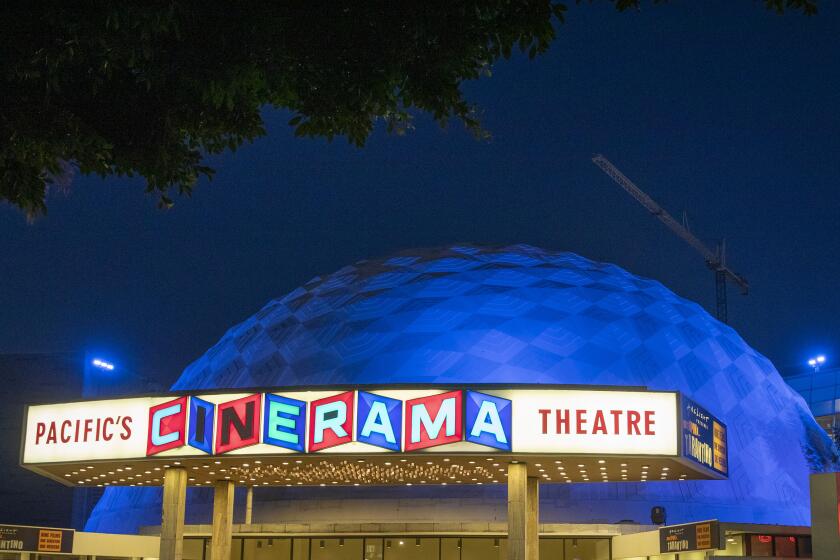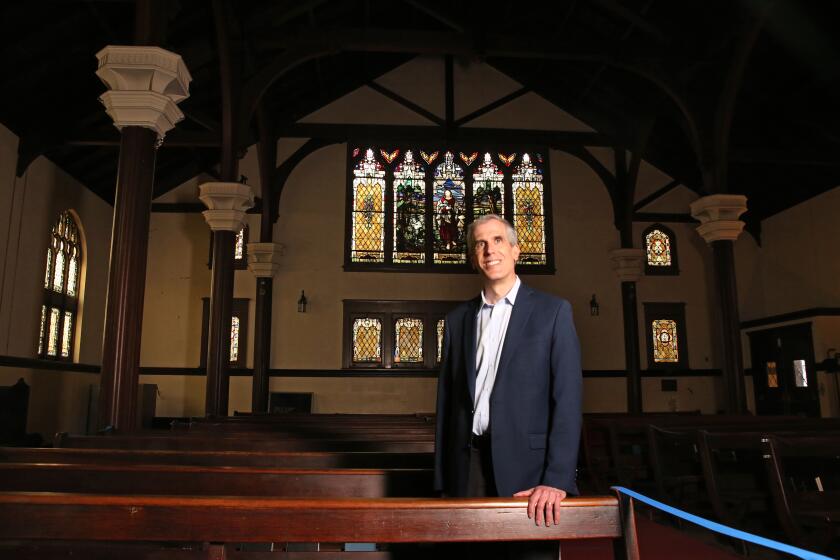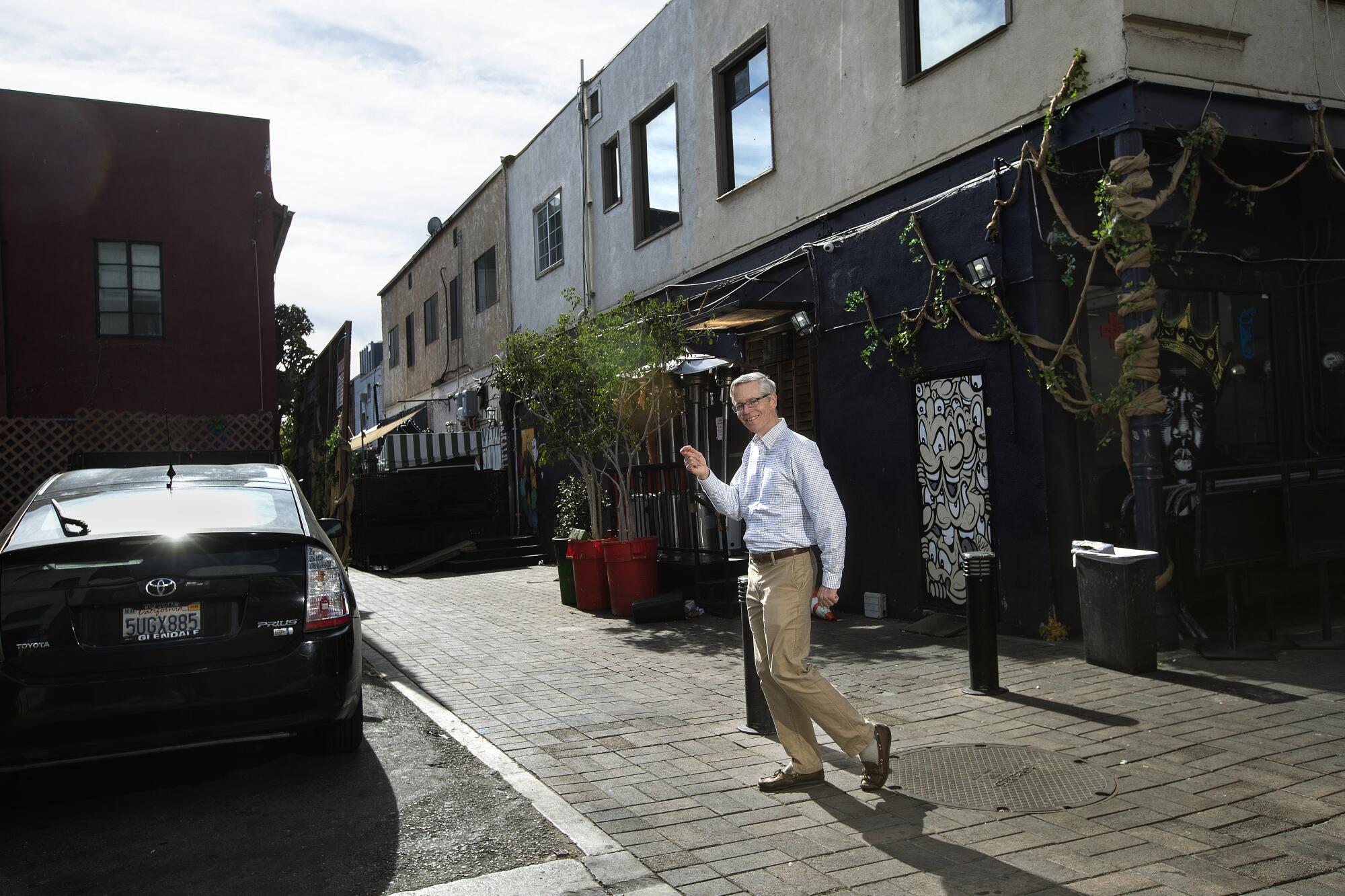
I dream of the day when the Hollywood the whole world associates with movie magic is brought back to life on the blocks tourists always come to see.
I dream of tourists leaving Hollywood Boulevard not underwhelmed and disappointed but thrilled by the richness of all they’ve learned there about the origins and history of the movies.
In this dream of mine, I see an especially bright future for a small alley just south of the boulevard, which at this moment could hardly be more obscure.
Because I think so many visitors to Hollywood would love to know about this unnamed space — where, in the early, exhilarating, madcap days of moviemaking, three of the greatest Hollywood stars of all time shot parts of three of their greatest films.
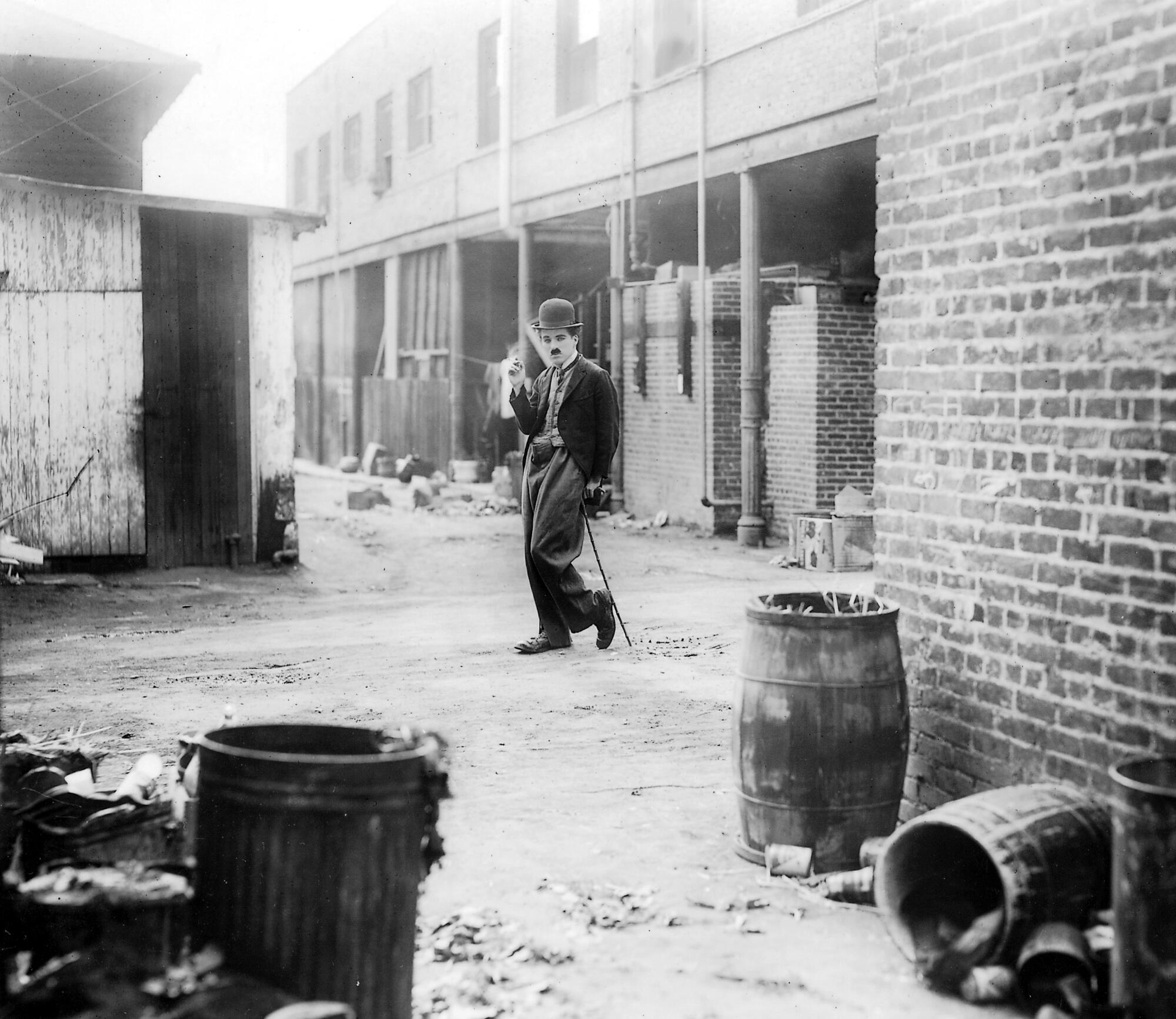
Here in this alley, which runs east to west from Cosmo Street to Cahuenga Boulevard, Charlie Chaplin’s Little Tramp first found an abandoned baby in “The Kid” (1921).
In this alley, Harold Lloyd headed to work through the employees’ back entrance of De Vore Department Store in “Safety Last!” (1923), best known for the iconic scene in which he hangs from the hands of the department store’s clock face high above a busy city street (filmed downtown).
Down this alley, Buster Keaton, chased by a pack of policemen, makes his thrilling escape by grabbing one-handed onto a moving car in “Cops” (1922).
There is no marker to indicate any of this in the alley — which currently is all but unseeable because much of it has been blocked and gated off by a restaurant and nightclub using it for outdoor space during the pandemic.
The alley’s anonymity, even before it was blocked, is to me the ultimate illustration of the problem with how Hollywood currently presents itself.
Hollywood is full of great film history, but a lot of it is not showcased well — if at all — to the millions who (sans pandemic) come looking for it each year.
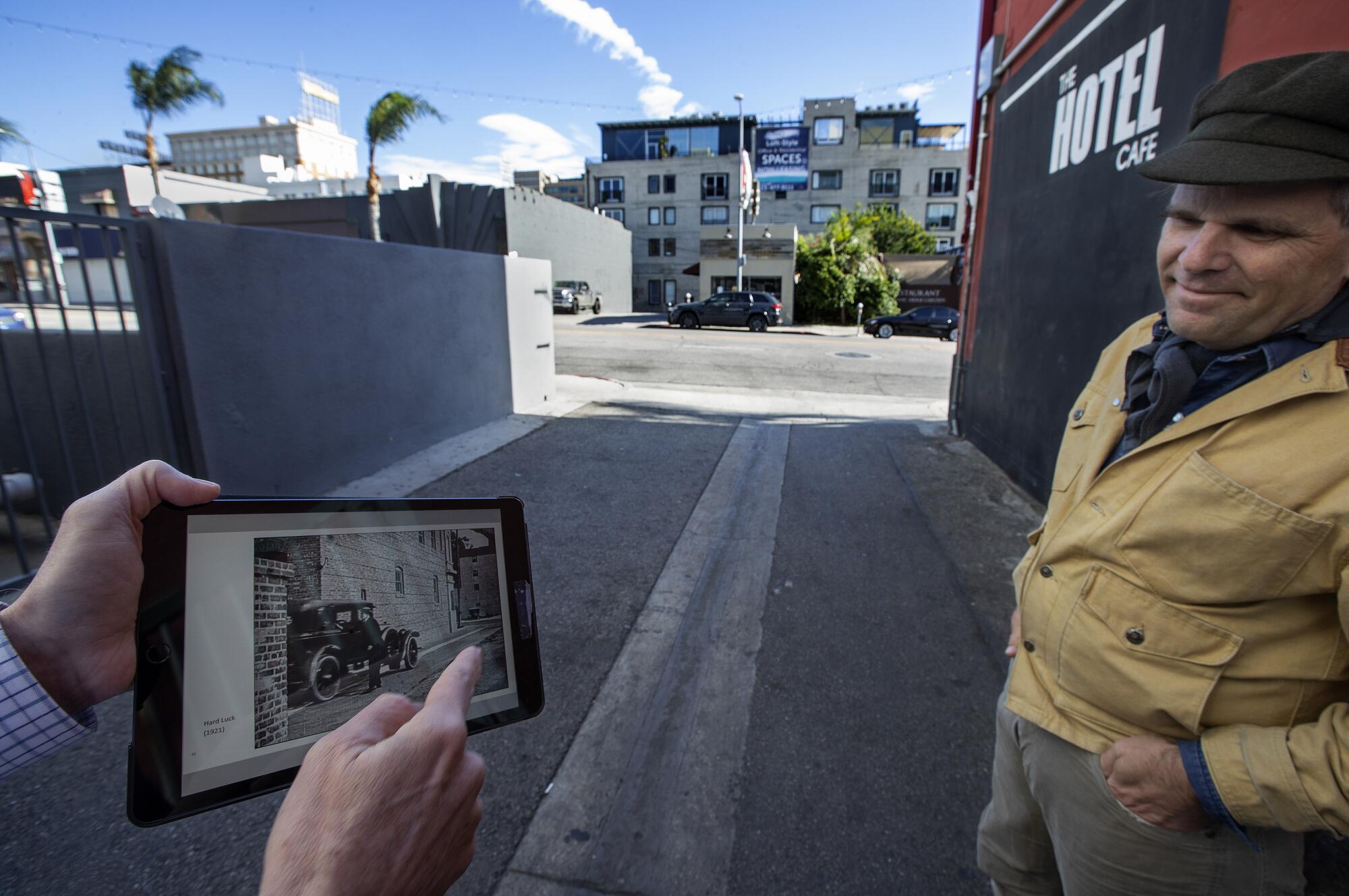
John Bengtson, the extraordinary detective who discovered the alley’s key role in silent films, has what seems to me a very modest wish. He’d like this humble space with no name to go forward bearing a proud one: the Chaplin Keaton Lloyd Alley. Maybe, he’s suggested, there could be a mural of the three silent-comedy greats in the alley too.
That would be a good start, but down the road I’d like to see much more — both for the alley and for other key spots that could help tell Hollywood’s story.
The ArcLight Hollywood with its Cinerama Dome means a great deal to Hollywood the neighborhood. Here’s hoping for a rescue that saves it but doesn’t try to reinvent something that works.
Personally, I think the city should solicit the help of the finest filmmakers in modern Hollywood to bring an earlier Hollywood to life on its streets in a way far more engaging and far less static for visitors than shuffling along staring at sidewalk stars or placing their hands into concrete handprints. But I’ll get back to that. First, let me tell you how Bengtson made his discovery.
Bengtson, who lives up north, in the East Bay, earns his living as a lawyer. But for decades now, in his free time, he’s been searching out the locations where silent movies were filmed by scouring historical photos to find matches for what he sees on the screen. He has a knack for remembering architectural details and patterns. He calls himself a “visual historian.”
The first seeds of this passion were planted when he was young and read a biography of Keaton. He took to watching Keaton’s films and other silents when they were shown on public television.
Then in 1995, Keaton’s films were re-released 100 years after his birth. Bengtson bought them on LaserDisc. He began noticing details — he recognized a scene shot in San Francisco — and the new technology let him freeze the frames and look closely. In one film, he saw the number on an apartment building in Los Angeles.
The next time he was there, he went to the Los Angeles Public Library and found that address by searching city directories. The building was still standing. He got excited. He set out to identify other locations.
In recent years, as more and more films and photo archives — including aerial photographs — have become available online, his ability to do these searches has grown by leaps and bounds.
Bengtson has published three picture books of his discoveries: “Silent Traces,” on early Hollywood as seen in Chaplin’s films; “Silent Echoes,” on early Hollywood in Keaton’s films; and “Silent Visions,” which includes glimpses of early Hollywood and New York as seen in Lloyd’s films. His blog, silentlocations.com, updates often with new discoveries.
Silent-movie fans are ardent, even if their numbers are relatively small, he points out. The comments they’ve written about the alley, identified on Google Maps, attest to that.
But many more people probably would enjoy knowing the history of those early days of filming — when scenes would be shot on the fly without permits right in the middle of everything. And what can be found in the early movies potentially has an even broader appeal to many in our city because they offer some of the greatest, most animated views of what L.A. used to look and feel like. In them, you can find in an earlier era so many places that still exist and also see so many other places long lost to us.
The Cinerama Dome, the Munch Box hamburger stand, the church where Aretha sang “Amazing Grace.” These are among hundreds of official L.A. landmarks. You can do your part to add to the list.
So far, Bengtson has identified 18 silent movies in which the little alley makes an appearance. They include work by numerous pioneering women in the film business, including Grace Cunard, Cleo Madison, Gale Henry and Lois Weber, the first woman to direct a U.S. feature-length film. The alley shows up in Weber’s “Where are my Children?” of 1916. Harry Houdini appears in the alley in “The Grim Game” (1919). Douglas Fairbanks, Oliver Hardy and Colleen Moore all can be seen there.
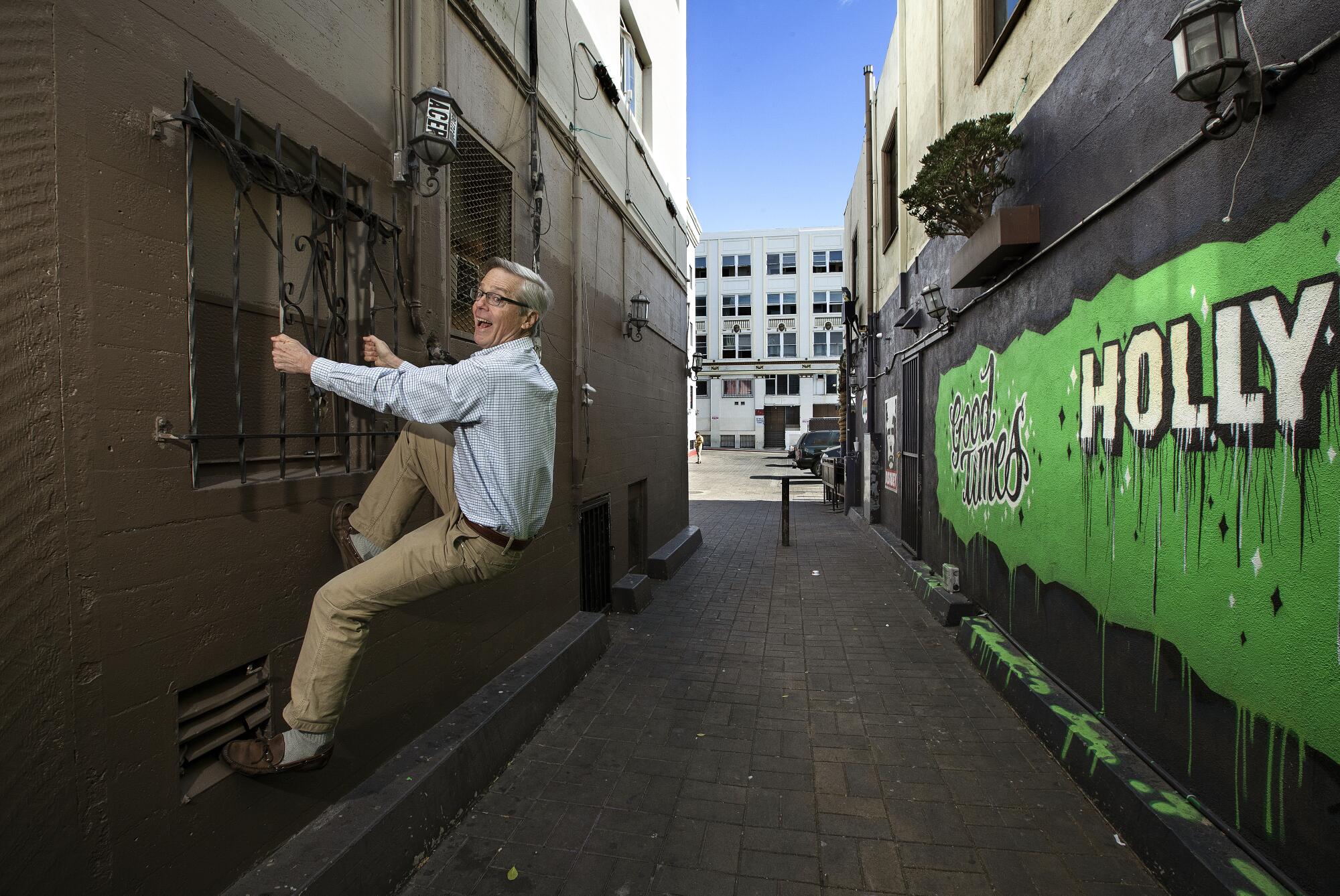
Bengtson guesses that many other films were shot in the vicinity too — one of the only citified corners in an early Hollywood that still mostly didn’t look urban. The alley offered a great scruffy setting. Its south-facing walls got sun all day. One building that still stands in it features a cast-iron support pole that can be seen in multiple movies. On the eastern end of the alley, on the east side of Cosmo, the side of Hollywood Boulevard’s Palmer Building, built in the early 1920s, could give certain shots a city feel without filmmakers trekking downtown.
And many more films, he points out — among them “Tillie’s Punctured Romance” (1914) — include city scenes filmed just around the corner on the 1600 block of Cahuenga Boulevard, which should also be pointed out to visitors.
Alas, just as we’ve lost a lot of our city’s built history, only a small fraction of the hundreds of silent films made survive. The nitrate film that was used at the time was highly flammable, and many films were destroyed in fires. After sound came in, many were junked as passé or melted down for the silver to be found in their emulsions. The Library of Congress estimated in 2013 that 75% of silent films had been lost. Some think that estimate is low.
Bengtson says Keaton, Lloyd and Chaplin appeared in the alley in multiple films, but he chose to emphasize three of the best-known films in particular because they are so “incredibly captivating.”
“They’re like spices that you don’t normally taste or colors you don’t normally see,” he told me. “The imagery and the story construction and the jokes — you can’t beat them.”
And it’s true; they somehow remain fresh and full of life a century after they were made.
I have to confess that Bengtson first showed me the alley last year, just before the pandemic hit. After we were shut in, the timing seemed off to tell you about it. But now as a lot of us worry about how Hollywood has fared without tourists, as we fret about the fate of the Cinerama Dome, I couldn’t think of a more perfect story to tell about the Hollywood history we need to tell better.
Back to my dream for how to do it. I think we can be a lot more creative than just putting signs up on street poles offering up history for tourists to read. What if there were key places on the boulevard where people could stop and watch short films made by today’s best Hollywood filmmakers — about the many famous writers who frequented Musso and Frank, about the first Hollywood premiere at the Egyptian Theatre, about how movies were made in their earliest days, when indoor scenes were filmed outdoors?
What if visitors could stand where Chaplin and Keaton and Lloyd once stood, in an alley proudly bearing their names, and watch them flicker back to life before their eyes?
More to Read
Sign up for Essential California
The most important California stories and recommendations in your inbox every morning.
You may occasionally receive promotional content from the Los Angeles Times.
